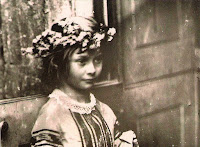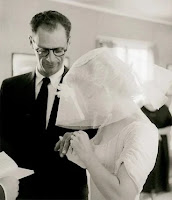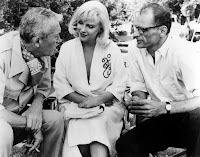Erinnern Sie sich noch daran? Ging einem nicht mehr aus dem Kopf, Grace Slick und Jefferson Airplane mit dem ✺White Rabbit. Bis heute nicht vergessen. Es war damals die Zeit der Drogen, die angeblich das Bewusstsein erweiterten. Was zuerst eine Sache für die Dichter gewesen war - ich denke da an Henri Michaux und Aldous Huxley (die mit Meskalin experimentierten) - war jetzt etwas für jedermann. Ich kann da nicht mitreden, ich lehnte dankend jeden angebotenen Joint ab. Pfeifentabak und Whisky reichten mir. Einen kleinen psychedelischen Trip hatte ich aber doch einmal. Mein Hausarzt, ein Freund meiner Eltern, hatte mir Butazolidin wegen einer Sportverletzung verschrieben. Es gab keinen Beipackzettel, die Ärzte behandelten ihre Familien damals untereinander kostenlos. Und meistens mit Warenproben. Ich konnte also nicht lesen, dass man zu diesem Zeug keinen Whisky trinken sollte. Ich sah in der Nacht nur noch rotierende gelbe Kreise, Pizzascheiben des Teufels. Irgendwie fallen mir dazu immer Noel Harrisons ✺The Windmills of Your Mind und Grace Slicks White Rabbit ein.
Ich glaube, dass das Butazolidin heute nur noch bei Pferden verwendet wird, macht aus lahmen Gäulen Rennpferde. Ich habe einmal gelesen, dass Prince Philip es aus dem Pferdestall entwendete, um seine gichtigen Finger damit zu kurieren. Ich weiß nicht, ob er auch Whisky dazu getrunken hat. Meine persönlichen LSD Geschichten sind hier auch schon zu Ende. Bis auf diesen kleinen Zettel, den mir unser witziger amerikanischer Lektor Jack Daugherty einmal vor Jahrzehnten zusteckte. National LSD Day: Mind, how you go! steht darauf, ich habe den Zettel noch immer. Ich nehme an, Jack wollte mich testen, denn der kleine Zettel war in Wirklichkeit ein Gedicht. National LSD Day war der Titel, Mind, how you go! die einzige Gedichtzeile. Man beachte bitte das Komma zwischen mind und how - das war der Gag dieses Einzeilers, den Roger McGough geschrieben hatte. Der Dichter aus Liverpool, der mir einmal ein Buch signierte, ist in diesem Blog mehrfach erwähnt worden, lesen Sie doch einmal die Posts Kathedralen, Pilzköpfe und Delmore Schwartz.
Aber kommen wir zurück zu der kleinen Alice: 'Begin at the beginning,' the King said gravely, 'and go on till you come to the end: then stop.' Ich werde beim Ende aufhören, es wird Ihnen nicht gefallen. Und ich habe das One pill makes you larger, and one pill makes you small von Grace Slick nicht vergessen: and she had never forgotten that, if you drink much from a bottle marked "poison," it is almost certain to disagree with you, sooner or later. However, this bottle was not marked " poison" so Alice ventured to taste it and finding it very nice, (it had, in fact, a sort of mixed flavor of cherry-tart, custard, pine-apple, roast turkey, toffy, and hot buttered toast,) she very soon finished it off. "What a curious feeling ! " said Alice, " I must be shutting up like a telescope." And so it was indeed: she was now only ten inches high, and her face brightened up at the thought that she was now the right size for going through the little door into that lovely garden.
A boat beneath a sunny sky,
Lingering onward dreamily
In an evening of July--
Children three that nestle near,
Eager eye and willing ear,
Pleased a simple tale to hear--
Long has paled that sunny sky:
Echoes fade and memories die.
Autumn frosts have slain July.
Still she haunts me, phantomwise,
Alice moving under skies
Never seen by waking eyes.
Children yet, the tale to hear,
Eager eye and willing ear,
Lovingly shall nestle near.
In a Wonderland they lie,
Dreaming as the days go by,
Dreaming as the summers die:
Ever drifting down the stream--
Lingering in the golden gleam--
Life, what is it but a dream?
For he will have known the awe that falls on one in the presence of a spirit fresh from GOD's hands, on whom no shadow of sin, and but the outermost fringe of the shadow of sorrow, has yet fallen: he will have felt the bitter contrast between the haunting selfishness that spoils his best deeds and the life that is but an overflowing love--for I think a child's first attitude to the world is a simple love for all living things: and he will have learned that the best work a man can do is when he works for love's sake only, with no thought of name, or gain, or earthly reward.
Die Zeichnung (oben) von E. Gertrude Thomson mit den drei nackten Mädchen zu seinen →Three Sunsets and Other Poems von 1898 hat Dodgson sicher gefallen, zeigt sie doch perfekt dieses verlogene süßliche Kinderbild der Viktorianer. Dodgson schrieb damals an Gertrude Thomson: I confess I do not admire naked boys in pictures. They always seem... to need clothes, whereas one hardly sees why the lovely forms of girls should ever be covered up. Deshalb hat er die Schwester von Alice auch genau so photographiert. Man weiß nicht ganz genau, ob das →Photo, das man unlängst in einem französischen Museum fand, wirklich echt ist, aber es spricht vieles dafür. Ah, happy he who owns that tenderest joy, The heart-love of a child! schreibt Carroll in einem →Gedicht. Feed your head.
Darf man ein Kind so photographieren, wie Dodgson das 1858 tut?... watch the way she measures a man with agile studio eyes, with dimpled depravity. Adult emotions of love and grief glissade across the mask of childhood, a childhood that is only skin-deep. It is clever, but it cannot last. Her admirers – middle-aged men and clergymen – respond to her dubious coquetry, to the sight of her well-shaped and desirable little body, packed with enormous vitality, only because the safety curtain of story and dialogue drops between their intelligence and their desire. Das schreibt kein Kommentator dieses lasziven Photos, das schreibt Graham Greene über Shirley Temple.
Diese Filmkritik durfte nicht gedruckt werden (lesen Sie hier mehr dazu), Graham Greene verlässt sicherheitshalber das Land. Der Lord Chief Justice sagt am Ende der Verhandlung: This libel is simply a gross outrage, and I will take to see that suitable attention is directed to it. So etwas darf nicht sein. Shirley Temple als inszeniertes Sexobjekt schon, aber man darf es nicht sagen. Von den viktorianischen Gemälden mit nackten Frauen eines William Etty, den Photographien von Lewis Carroll, der Werbung von Pears Soap (hier im Bild) bis zu Christine Keeler versuchen die Engländer immer einen Schein von Anständigkeit für ihre Schmuddelphantasien zu wahren.
Der Sommer des Jahres 1862 bringt noch ein weiteres literarisches Produkt unseres Oxford Mathematikers hervor, nämlich den →Song über Miss Arabella Jones:
'Tis a melancholy song and it will not keep you long,
Tho I specs it will work upon your feelings very strong,
For the agonising moans of Miss Arabella Jones
Were warranted to melt the hearts of any paving stones.
Simon Smith was tall and slim, and she doted upon him,
Im Jahre 1921schrieb der englische Schriftsteller J.B. Priestley: Alice in Wonderland and Through the Looking-Glass are, I understand, to be published for the first time in German. When I first learned this important fact, it surprised me for a moment, for I had thought that both these classics had by this time passed into all civilized tongues; but after some little reflection, I soon realized that if they had been popular in Germany, we should have known about it. It is not difficult to imagine what will happen when the Alice books are well known there, for we know what happened to Shakespeare. A cloud of commentators will gather, and a thousand solemn Teutons will sit down to write huge volumes of comment and criticism; they will contrast and compare the characters (there will even be a short chapter on Bill the Lizard), and will offer numerous conflicting interpretations of the jokes. After that, Freud and Jung and their followers will inevitably arrive upon the scene, and they will give us appalling volumes on Sexualtheorie of Alice in Wonderland, on the Assoziationsfähigkeit und Assoziationsstudien of Jabberwocky, on the inner meaning of the conflict between Tweedledum and Tweedledee from the psychoanalytische und psychopathologische points of view. Das wird alles kommen, da kennt Priestley den deutschen faustischen Geist, der alles ergründen will, schon recht gut. Ich mache mir das mit der Rezeption des Werkes einfach und verweise auf das Buch Lewis Carroll - Alice in Wonderland and Through the Looking- Glass von Eberhard Kreutzer. Da steht alles drin, was man wissen will.
Wenn Charles Lutwidge Dodgson am 4. Juli 1862 im Boot die Geschichte von der kleinen Alice erzählt, die sich langweilte - so wie Alice Liddell sich gerade langweilt - dann heißt das nicht, dass er das ganze Buch schon im Kopf hat. Er wird drei Jahre dafür brauchen. Aber das Konzept zu dem Ganzen, das gewinnt er während einer Eisenbahnfahrt nach London. Er wollte die Weltausstellung mit ihrer Wunderwelt besuchen. Er liebte die Eisenbahn. Schon als Elfjähriger hatte er für seine Geschwister ein Eisenbahnspiel ersonnen, das von seinen vielen Geschwistern nach den von ihm festgelegten Regeln gespielt wurde (das Manuskript dazu liegt heute in Harvard). Es ist immer Lutwidge, der die Regeln festlegt, nach denen die Kinder spielen. So beherrscht er sie. Wie er Alice mit seinen Erzählungen beherrschen will - der Zauberer, der Kinder fängt.
Aber, um einen Filmtitel der fünfziger Jahre zu zitieren, sie tanzte nur einen Sommer, da brach der Dean von Christ Church Henry George Liddell die Beziehungen zu Dodgson ab. Hatte er die pädophilen Gelüste seines theologischen Kollegen erraten? Wir werden es nie erfahren, die Erben von Dodgson haben alle Seiten seines Tagebuchs aus dieser Zeit vernichtet. Wir wissen auch, dass Alices Mutter alle Briefe von Dodgson an die kleine Alice beseitigt hat.
I charm in vain; for never again,
All keenly as my glance I bend,
Will Memory, goddess coy,
Embody for my joy
Departed days, nor let me gaze
On thee, my fairy friend!
Was immer geschehen ist, die Katze lässt das Mausen nicht. Seit Ende der 1860er Jahre baut er sein →Photostudio in seinem College aus, er legt auch Listen seiner Opfer an. Einhundert und sieben Namen stehen darin. Don Giovanni hatte ein wenig mehr: Ma in Ispagna son già mille e tre, aber das waren richtige Frauen, keine Kinder. 1867 macht Dodgson seine erste Nacktaufnahme: Mrs. L. brought Beatrice, and I took a photograph of the two; and several of Beatrice alone, 'sans habilement [sic ]. Beatrice ist Beatrice Hatch, die jetzt sein bevorzugtes Modell wird. Und dann ist da noch ihre Schwester Evelyn, von der er dieses schöne, geschmackvolle Photo macht.
Mabel Amy Burton, die er 1877 als Achtjährige kennenlernte, erinnerte sich As a small child I much disliked strangers, but the personality of this gentleman attracted me and I chatted away with him quite freely. Sie sprach nach seinem Tod von einem irreparable loss in the hearts of many who had been his child-friends. Der irreparable Schaden ist noch größer. Vielleicht sollte man Alice in Wonderland in Malice in Wonderland umbenennen. Auf den Gag war Dodgson selbst auch schon gekommen, so schreibt er 1867 in einem Brief an Agnes Argyle: Dear Miss Dolly, I have a message for you from a friend of mine, Mr. Lewis Carroll, who is a queer sort of creature, rather too fond of talking nonsense. He told me you had once asked him to write another book like one you had read - I forget the name - I think it was about “Malice.” 2015 (da stand der größte Teil dieses Post hier schon einmal) ist nicht nur das Jahr von 150 Jahren Alice, es ist auch das Jahr, in dem dieses Photo vom Reverend Charles Lutwidge Dodgson und der kleinen Alice auftauchte. Muss man noch mehr sagen? Mind, where you go.
Lesen Sie auch: Charles Lutwidge Dodgson, Alice, Penelope Boothby











































